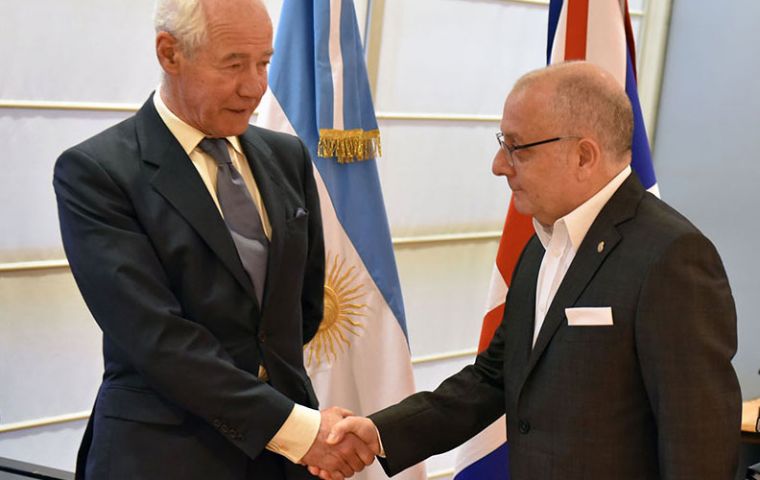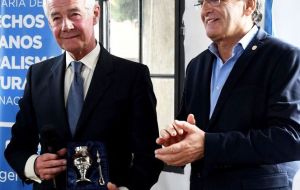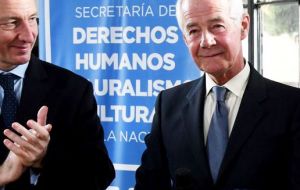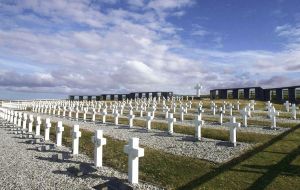MercoPress. South Atlantic News Agency
Argentina pays homage to UK military officer for helping identify soldiers fallen in 1982
 Geoffrey Cardozo is received by foreign minister Jorge Faurie
Geoffrey Cardozo is received by foreign minister Jorge Faurie  Human Rights secretary presents Cardozo with a mate
Human Rights secretary presents Cardozo with a mate  The ex UK military officer with ambassador Mark Kent
The ex UK military officer with ambassador Mark Kent  The Argentine Memorial at Darwin where a special ceremony will take place next Monday
The Argentine Memorial at Darwin where a special ceremony will take place next Monday Families of Argentine soldiers killed in the 1982 South Atlantic conflict with Britain have paid homage to a former British army officer who helped recover and rebury with dignity and precision their loved ones in a Falkland Islands cemetery, which would become the Argentine military cemetery or memorial.
The humanitarian effort of ex Colonel Geoffrey Cardozo, and his meticulous job, decisive for helping identify at least 90 of 123 unknown graves 35 years later, was also acknowledged by the Argentine foreign minister, the Human Rights Secretary and Congress in special ceremonies.
A highly specialized multinational forensic study looking for matching DNAs volunteered by the next of kin, which was agreed by Argentina, UK and with the support from the elected government of the Falklands, and conducted by the Red Cross, helped identify (so far) the remains of 90, of the 123 unknown graves in the military cemetery at Darwin.
The identification process was possible thanks to the efforts of then Captain Geoffrey Cardozo. In effect back in 1982, when the war was over and the retreating Argentine forces abandoned their dead comrades, Cardozo assembled a team of British funeral directors that rappelled into minefields from helicopters and dug up mass graves to recover the Argentine corpses. They then carefully prepared each one for reburial in individual coffins.
The young captain meticulously completed what was to be known as the Cardoso Report, with details of each grave, including anything which could help at some point identify the remains since the Argentine fallen did not have dog tags. It was precisely this work that would help 35 years later the identification task during the second half of 2017.
On Friday Cardozo, accompanied by UK ambassador Mark Kent, began the round of contacts at the Foreign ministry where minister Jorge Faurie thanked and praised the former British officer for his professionalism, particular care and respect, which “was fundamental for the success of the identification process” of the Argentine fallen
The second stop was in Congress where Cardozo and ambassador Kent were received by the Lower House Foreign Affairs committee, and chairwoman Cornelia Schmidt Liermann. Cardozo was joined by Julio Aro, a Malvinas veteran and president of the foundation “Don't forget me”, which for years lobbied for the identification of the remains at the military cemetery. Maria Fernanda Araújo, president of the Malvinas fallen relatives Commission and officials from the foreign ministry also attended.
“It is for us a great honor to receive today Geoffrey Cardozo, a man with a humanitarian commitment for our fallen soldiers that must be underlined and for which we must express our gratitude”, said lawmaker Alejandro Echegaray. “Thanks to his work, so respectful, today we are able to seal a wound which is that the soldiers who gave their lives for the Malvinas, now have a name and their families know where they rest”
Aro added that the Cardozo Report on each of the soldiers buried was decisive for the Red Cross team to identify 90 of 122 remains interred at the cemetery, in the framework of the humanitarian plan implemented by the governments of Argentina and UK.
At the Human Rights Secretariat, Claudio Avruj presented Cardoso with a mate, the River Plate cup for the infusion tea, which is a symbol of friendship and sharing, and praised the ex military officer commitment.
“We are here to pay homage to a great friend of Argentina, who enabled that our heroes who sacrificed their lives for our motherland in 1982, can now rest in peace. Today thanks to the joint toil, we are en route to know the truth”, said Avruj.
Cardozo who referred to the Argentine conscripts as “my boys” said “I has a responsibility towards these boys, orphans, which had proved to be formidable combatants. I did everything possible to identify them”.
Ms Araujo confessed that at first “we mistrusted, we were convinced they wanted to identify the remains to bring them over to the continent...I remember my mother telling me she opposed me working with the graves, but then changed her opinion. One day she told me 'who am I to prevent another mother to know whether her child is in the cemetery or not'”.
Ambassador Kent revealed that the identification process of the combatants, absolutely non-political, has been his most important task since becoming ambassador in Argentina.
Cardozo next Monday will be part of the humanitarian flight to the Falklands with the 200 plus relatives of the recently identified Malvinas fallen, clergy representatives, and Argentine officials headed by Claudio Avruj, that will be participating in a special one day ceremony at the Argentine Memorial, where now 90 out of 123 non identified graves have tombstones with their complete names.




Top Comments
Disclaimer & comment rules-

-

-

Read all commentsWhy didn't the fallen soldiers have dog tags?
Mar 24th, 2018 - 05:19 pm +6Incorrect about the coffins- Col.Cardozo buried each one in a double body bag as there were no coffins. Now yes - each of those who were exhumed, was placed in a coffin and reburied.
Mar 24th, 2018 - 10:37 pm +6Thnk,
Mar 25th, 2018 - 10:47 pm +5you are correct, in most cases all Argentines who were killed in bombardments or whatever were indeed pretty promptly buried by their comrades albeit in temporary mass graves as in the Stanley civilian cemetery. The British did exactly the same with theirs on land taking them back to a temporary cemetery just by the Ajax Bay field hospital, others were taken to and buried at Teal Inlet from the final battle battle hills around Stanley to the north.
As the Argentines were at the end falling back rapidly they had no means nor time to bury their dead - I imagine the British had the same problem in 1940 at Dunkirk and many of their war dead would have been collected and buried by the Germans after.
Have no doubt that under the circumstances both sides did their best for theirs and the other sides dead - there was a war going on after all.
Commenting for this story is now closed.
If you have a Facebook account, become a fan and comment on our Facebook Page!